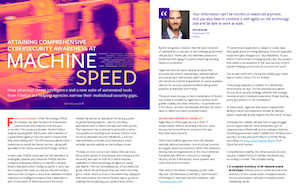- Sponsored
- Sponsored Content
How to address security visibility across multicloud environments

Federal cybersecurity leaders are under growing pressure to protect government resources amid sweeping changes within their organizations’ IT operations. Though agencies typically maintain defined perimeter controls, the trajectory towards distributed environments means that modern security practices require a different approach.
The answer to better security starts with closing the visibility gap — and security tools that can respond to the rapid evolution of cyberattacks without being further drain on resources, says a new report.

Read the full report.
The report, produced by FedScoop and underwritten by FireEye, highlights how a new suite of automated tools is helping agencies narrow security gaps as federal agencies continue to build out multi-cloud environments.
Those tools are part of a platform developed by FireEye — a global leader in cybersecurity intelligence — following a series of acquisitions in the last seven years. FireEye’s acquisition of Mandiant, in 2013, provides widely regarded expertise in breach response and consultancy; and Verodin, acquired most recently (now known as Mandiant Security Validation), provides a comprehensive set of cybersecurity risk assessment tools.
“FireEye can now come in and deploy what we know about every variant of ransomware we’re seeing around the world, and start to look for it within minutes, regardless of which technology an agency is using,” says Ron Bushar, government CTO for FireEye.
FireEye is strengthening its reputation as an industry leader on global hacking exploit awareness and can provide the automated tools to detect and deal with them quickly. The company’s response and intelligence experts have responded to tens of thousands of breaches around the world, the report says.
That is why tools that boost visibility in a distributed environment offer “the essential foundation of any cloud security strategy, whether that strategy revolves around compliance assurance, threat hunting, policy governance or risk remediation,” adds Martin Holste, cloud CTO for FireEye.
Achieving that visibility remains an urgent need for most enterprises. The report cites a 2020 Cloud Security Report from Cyber Security Insiders which found that 43% of cybersecurity professionals across multiple industries, including government, listed “visibility into infrastructure security” as a key challenge.
According to Holste, comprehensive visibility into infrastructure security will require simultaneous controls, including:
- A complete inventory of all relevant assets at all times.
- Contextual details on the current state of every asset.
- The complete historical record of security events for each asset.
Agencies are not alone in managing capacity problems to maintain talented cyber skillsets. The spike in employees working from home has meant adapting security monitoring and detection capabilities across most sectors. Having to perform those security functions remotely is putting a strain on security teams and made the need for scalable tools even greater.
Having a robust suite of analytics and detection tools — that can monitor and enforce security policies, detect new types of vulnerabilities, and that can distinguish between shifts in behavior versus unusual behavior — is more important than ever.
Learn more about the suite of FireEye detection, protection and response capabilities to attain cybersecurity awareness at machine speed
This article was produced by FedScoop and sponsored by FireEye.






